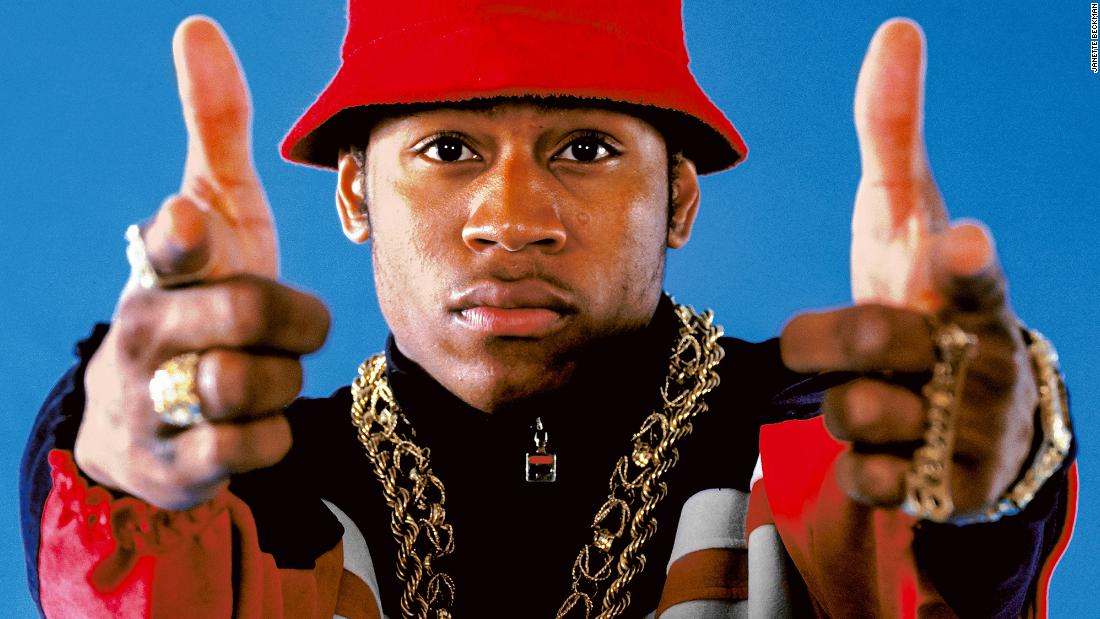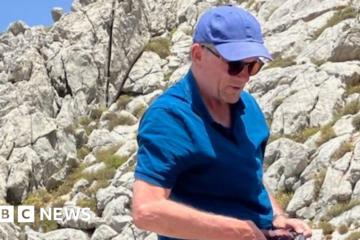Diddy wears layered chains and iced-out medallions in 2016. (Justin Jay)
Jewelry is as much a staple of hip-hop as mics and mixtapes.
Rappers have an increasingly flamboyant taste for gold and ice. For some, the sparkling adornments stand as homage to the opulence and traditions of ancient African kings and queens. For others, it speaks to the royal stature the musicians enjoy in modern society.
For artists like Slick Rick — one of the first to take jewelry to the heights many fans have come to expect — it’s about being seen, he told CNN.
“Big pieces are my thing. On stage, I want the concertgoers and supporters to see and feel my pieces from the farthest seat in the house,” said the rhymesmith, who penned the opening essay in the new book, “Ice Cold: A Hip-Hop Jewelry History.”

Slick Rick has long donned marks of royalty, as seen in this 1988 photo. (Janette Beckman)

Megan Thee Stallion shows off her diamond grill with a matching pendant. (Zach Boisjoly)
As journalist Vikki Tobak points out in the book — her follow-up to 2018’s “Contact High: A Visual History of Hip-Hop” — it wasn’t always this way.
Rap was born in the streets of humble origins. Long before Eminem sold out Australian cricket grounds and Dr. Dre put on an Emmy Award-winning Super Bowl show for 100 million viewers, rappers and DJs had to spit and spin their way through the parks, community centers and gyms that gave birth to the genre.
Early innovators such as DJ Kool Herc and Grandmaster Flash weren’t rocking big chains and rings as they moved parties in the 1970s. Early images of the Cold Crush Brothers show them in fly matching suits and plenty of leather, but with minimal bling.

Fast-forward through the next half-century and you see a rapid progression, from Big Daddy Kane and LL Cool J, whose rings stretched across their entire hands, to Nas’ diamond-flooded QB pendant shouting out the Queensbridge Houses that raised him, to Lil Jon wearing a “Crunk Ain’t Dead” ensign as big as his head.
Today, the only limit is a rapper’s imagination. It’s not uncommon to see, as T-Pain and Akon once rhymed, “a house around my neck,” whether it’s Pharrell’s jewel-encrusted N.E.R.D. pendant or Rick Ross’ glimmering effigy of … Rick Ross. Slick Rick writes in the book that the first time he saw Wu-Tang Clan’s Ghostface Killah don his famed Versace plate and the 6-pound solid gold eagle on his wrist, “I was up in the stands clapping approvingly.”

Tobak — who emigrated from Kazakhstan to Detroit at age 5 and credits music with helping her understand the United States, its language and its history — was inspired to pursue the book, in part, by a documentary from Quality Control, the label that helped propel Migos, Lil Baby and Lil Yachty to fame.
Long influenced by hip-hop culture and the stories that undergird it, Tobak was drawn to the messages of empowerment promulgated by the likes of Public Enemy and EPMD. As a teen, she moved to New York, where she first worked as a cashier/doorwoman/receptionist at Nell’s, the nightclub where The Notorious B.I.G.’s “Big Poppa” video was shot. She went on to Payday Records, where she met Guru and DJ Premier, the duo better known as Gang Starr, and later worked for Vibe, Paper and Mass Appeal, among others, as she expanded the network she’d later tap for her books.
Tobak recently sat down with CNN to discuss “Ice Cold.” The interview has been edited for length and flow.

Rakim, left, wears a Mary pendant while Eric B. is draped in gold, including a four-finger ring spelling out his full name in 1987. (David Corio)

In the late 1980s, four-finger rings were must-haves for many rhymesmiths. Here, Biz Markie shows off his own iteration in 1988. (George DuBose)
What drew you to this topic?
I love telling the stories of hip-hop through unique angles. As I was doing “Contact High,” obviously I started picking up on all the little details, all those visual signifiers that you would see in photos that carried so much meaning — and jewelry was the most obvious one, other than clothing and clothing styles. But jewelry was such an important personal piece of adornment from the very start and had this historical meaning, and so I was always really interested in how people choose to adorn themselves and what that message is — especially in the world of hip-hop, where all of that is so important and layered and has a lot of meaning.

LL Cool J was one of the first to take jewelry to a new, huge level, as evidenced by the thick dookie ropes and multifinger ring he wore in 1986. (Janette Beckman)

Jesus piece, “Don Life” pendant, diamond grills and a 4-carat emerald: Big Sean leaves nothing unadorned in 2021. (Raven B. Varona)
Jewelry starts off subdued until around the time you see Run-DMC rocking big chains in the 1980s, and then it gets more ostentatious. Talk to me about how it got to where it is today.
The arc of hip-hop jewelry is really incredible. As in true hip-hop style, they show up and show out like no one else. In the beginning, pre-Run-DMC, the first instance where jewelry was seen on a hip-hop album was Kurtis Blow’s debut album — and those chains were really small, for lack of a better word. At the same time, what was happening in hip-hop in that moment, the heroes for the hip-hop guys at the time were the street legends — the drug dealers, the hustlers, the guys in the street that were wearing these big pieces and could wear those big pieces because the street was the runway and you wanted to show it off as your status and wealth and your place in that ecosystem. So the people that would become hip-hop artists, the people that they were looking to were the guys in the street.

Even the early jewelers like Tito Caicedo, who worked at his father’s store called Manny’s, their main clientele for jewelry were the hustlers — the street elite, as I like to call them — and then the rappers followed suit because they wanted to be like them. You started to see Eric B. and Rakim. You started to see Run-DMC, like you said. You started to see even women like Salt-N-Pepa wearing the big dookie ropes and wearing the big Nefertiti pendants. You started getting the Mercedes symbol, and then it started to get more and more serious, and it sort of goes in tandem with the way that hip-hop grew as well. The jewelry grew as hip-hop grew and changed. That’s why I start the book talking about this bigger cultural significance and what was happening in New York specifically at that time — the height of the drug trade, the ’80s. All of that stuff really reflected in the jewelry, and you had to have a certain level of respect and protection if you were going to wear that stuff in the street.

It’s tough to discuss the history of hip-hop jewelry without mentioning the many clocks of Public Enemy’s Flavor Flav, seen here in 1994. (Jesse Frohman)

The late Shock G of Digital Underground was known for his extravagant style, and during this 1990 shoot he rocked a Nefertiti ring. (Jesse Frohman)
A lot of entertainers are flashy. What is it about hip-hop that puts it over the top?
The role of adornment and how you presented yourself was so important, and I think you also see that across the Black community, where the way you dress and hold yourself has this additional layer of importance, if you will, and with hip-hop that commonality of respect and also remixing — not just in music, but remixing in fashion — having something that nobody else has. That’s what you saw with early Dapper Dan. You saw that with early sneaker customization. That is very much a hip-hop culture signifier, so remixing and that uniqueness of wanting to stand out and be different is something that hip-hop really specializes in.
Is there a larger race factor involved here?
The short answer is: absolutely. You can’t talk about hip-hop without talking about the history of Black culture, and you can’t really talk about the history of Black culture without all those larger political, social, racial aspects of it. Traditionally, the lack of wealth, the lack of generational wealth, the lack of being able to have certain material opportunity, that takes on a whole different aspect when you add race to the picture. Hip-hop has this beautiful messaging about transcending your circumstances, rising above. I think that ties all back into race as we kind of grappled with this imbalance of resources that is really part of a larger historic political story.

You devote an essay in the book to this, but talk to me about hip-hop style as subversion.
There’s been certain thinkers in hip-hop, and sort of hip-hop adjacent, that really understand the role of hip-hop style as a bigger message. Malcolm X is somebody that we dedicated a full page to. He very strategically made sure to play his ring with the Nation of Islam symbol right smack dab in the frame. He kind of directed the photographer to take that photo. You will often see rappers today very strategically lifting up their sleeve to show the watch, or posing with certain symbols: label chains, the Roc-A-Fella chain, the Cash Money chain. There’s certain people that understand messaging out those pieces of jewelry to point to who those people are, to point to what community they’re part of, to point to their beliefs. Even wearing an ankh (an Egyptian key of life symbol), Beyonce and many people in the book are wearing ankhs and Nefertiti. Kanye, even with his Jesus pieces — that sort of subverting a role that society may have for you and saying: “No, actually look at what I’m wearing. I actually believe something else. You may not even hear me, but when you look at me, you’re going to know what I’m about.”

From left, Takeoff, Offset and Quavo of Migos — photographed in 2018 — define drip, from their shades and belt buckles to the millions around their necks. (Travis Shinn)

In 2009, Nicki Minaj shows off a pendant celebrating one of her many alter egos. It hangs from a diamond tennis chain. (Angela Boatwright)
You talked about Atlanta helping inspire the book. ATLiens, of course, have a different path to fame than do New York and Los Angeles artists. When we see Gucci Mane’s and Migos’ pieces, does that more circuitous route play into the elaborate nature of their jewelry?
Jewelry culture is very regional, from New York to LA to the South. I do think Atlanta, being the more recent kingdom, really kind of puts those Southern aesthetics into it — doing things a little bigger, a little flashier, a little more laid-back, if you will. But the jewelry is on a whole different level only because they’re coming up at a time when there’s so much to be done in jewelry. Gucci alone has brought in all the colored gemstones, anime figures and cartoons. That’s also just what these guys were into and watching growing up, right? But the South has really kind of taken it to this next level.

Tell me about your favorite piece in the book.
There’s a photo by Michael Lavine of Biggie with his Jesus piece, and I love that photo just because all those browns, the coat, the background — it’s just a really beautiful photo of him. But the Biggie Jesus piece is kind of the Hope Diamond of hip-hop. It is a piece that really kicked off the Jesus piece trend in hip-hop. A lot of people think it’s Kanye, but it was Biggie, and it was made by sort of the first hip-hop jeweler, Tito Caicedo. That piece, even though it’s simple and it has been sort of re-created over and over, I would say that that’s my favorite — just how layered in history and meaning it is, and that it’s Biggie and Tito.
Beyond that, I love (designer) Ben Baller’s Kid Cudi (Japanese artist Takashi) Murakami piece. That just sort of speaks to how the jewelry has become so personal and artistic. Tyler (the Creator) is my favorite artist for jewelry in this book because he’s having so much fun with it. He is working with Ben Baller and all these other jewelers and he’s having just so much fun and he’s clearly influenced by Pharrell, and admittedly so, and really has the freedom to design any kind of pieces. His “IGOR” pendant that he got made as part of his “IGOR” album is incredible, and he just has really good taste — almost like the way that Elizabeth Taylor had a collection with taste and big significant pieces. I sort of feel like Tyler has that same energy about him.

Biggie’s Jesus pieces, seen here in 1997, began a trend. Jay-Z, who owns one of them, once wrote that he wears it when he records an album. (Michael Lavine)

Cam’ron’s spinning-globe charm had a motor and 100 carats worth of diamonds, some spelling out “Killa Cam Harlem World.” (Phil Knott)
How about your favorite anecdote?
Cam’ron had a piece made by Rafaello & Co very early on, and it was the spinning globe piece, which is a very famous piece. It had a working motor and actually spun, and it was considered a very unique piece for the 2000s for using multicolored gems and being round and just being this very ostentatious piece. I guess years later, Cam’ron got a little bored of it and was going to trade it back in for something. A lot of times the jeweler would deconstruct a piece like that, which is crazy to me, but they would take all the gemstones out, they would melt down the gold and make something else. Lil Yachty got word that Cam’ron was getting rid of this piece, and it had been such an influential piece for him — he’s such a significant collector as well — and he came to the rescue and said: “Oh, my God, you can’t get rid of that piece. You can’t melt it down. I want it.” So he bought it and then he changed it to say, “Yachty’s World.” Yeah. So, that piece was rescued and lived on, and it takes on this whole new generational meaning. I love that story.
Vikki Tobak’s “Ice Cold: A Hip-Hop Jewelry History,” published by Taschen, is now available.
Note:- (Not all news on the site expresses the point of view of the site, but we transmit this news automatically and translate it through programmatic technology on the site and not from a human editor. The content is auto-generated from a syndicated feed.))



